| Columns Retired Columns & Blogs |
KEF Reference 207/2 loudspeaker Measurements
Sidebar 3: Measurements
Like the original KEF Reference 207, the Reference 207/2 has a voltage sensitivity that is significantly higher than average, at an estimated 91dB(B)2.83V/m, as specified. But also like the earlier version, the 207/2's impedance averages 4 ohms throughout the bass and lower midrange, with a drop to 3.5 ohms in the high treble (fig.1). The absence of the usual double impedance hump in the bass implies that KEF has used some sort of conjugate network at low frequencies in order to make the speaker resemble a resistive load. Certainly the phase angle is generally low, meaning that the speaker should not be that hard to drive, even with its 4 ohms impedance magnitude over much of the audioband. Something that will be a factor, if the KEF is used with a tube amplifier having a fairly high source impedance, is that the impedance peak in the presence region will tend to make the speaker sound a little bright with such an amp.
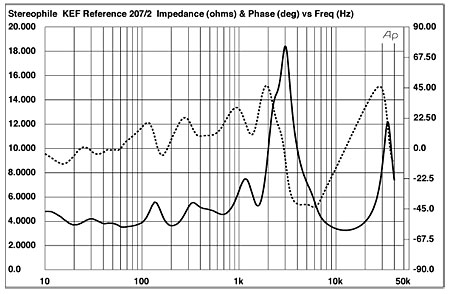
Fig.1 KEF Reference 207/2, electrical impedance (solid) and phase (dashed). (2 ohms/vertical div.)
The impedance traces are free from the small discontinuities that would indicate the presence of panel resonances. In fact, the only mode I could find was on the center of the curved sidewall at 223Hz (fig.2), but even this is well down in level. Given how difficult it is to minimize panel resonances in large speakers, KEF has obviously paid careful attention to the 207/2's cabinet construction. The cast-aluminum high-frequency enclosure was completely inert.
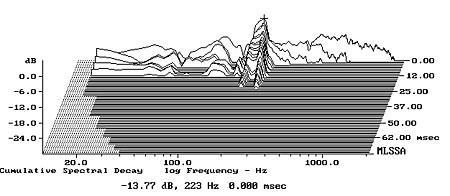
Fig.2 KEF Reference 207/2, cumulative spectral-decay plot calculated from the output of an accelerometer fastened to the center of the main cabinet's sidewall (MLS driving voltage to speaker, 7.55V; measurement bandwidth, 2kHz).
The traces in fig.3 show the summed output of the ports (green trace), the summed output of the twin woofers (red), and that of the lower-midrange unit (blue), all measured in the nearfield. The magenta trace in this graph is the lower-midrange unit's response, measured in the nearfield below 400Hz, and, in the farfield, on the tweeter axis above that frequency; the black trace is the coaxial Uni-Q tweeter's farfield response, again taken on the tweeter axis. The port is tuned to a low 26Hz, this revealed by the notch in the woofers' response at that frequency, though its output peaks rather more broadly than I expected. The crossover frequencies are close to those specified, and all the acoustic crossover slopes appear to be fourth-order. Notably, every drive-unit's behavior is flat within its passband and smoothly controlled out-of-band. This is textbook loudspeaker design.
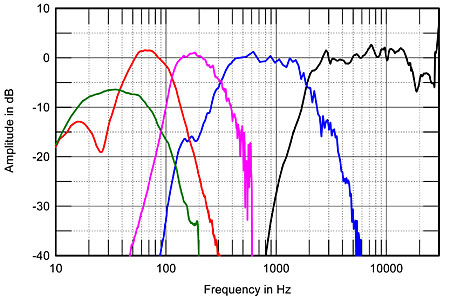
Fig.3 KEF Reference 207/2, nearfield responses of ports (green), woofers (red), lower-midrange unit (magenta), upper-midrange unit below 400Hz (blue), all plotted in the ratios of their radiating diameters, with the farfield responses of the upper-midrange unit above 400Hz (blue) and the tweeter (black).
The KEF's overall response, averaged across a 30° horizontal window on the tweeter axis and with the jumpers set for flat response above 1kHz, is shown in fig.4. The 207/2's response is both impressively flat and more even through the treble than the original 207's. The speaker's output shelves down a little above 15kHz, before returning to full level at the 30kHz limit of this graph. (My measurement microphone is calibrated up to only 30kHz, which is why I end the plot there.) Early variants on the Uni-Q coaxial design, even in the original 207, had some discontinuities in both the axial response and the dispersion between 5 and 10kHz, but the 207/2' s response in this region is smooth and even. At the other end of the spectrum, the mid-to-upper bass appears to shelve up by 3–4dB; this is entirely due to the assumptions made by the nearfield measurement technique, meaning that the speaker will actually be maximally flat in the bass down to 35Hz or so, and –6dB at the port tuning frequency of 26Hz, as specified.

Fig.4 KEF Reference 207/2, anechoic response without grille on tweeter axis at 50", averaged across 30° horizontal window and corrected for microphone response, with the complex sum of the nearfield responses plotted below 300Hz.
Not only is its on-axis response flat, the 207/2's off-axis behavior is even and smoothly controlled (fig.5). The speaker does become increasingly directional in the high treble, but without there being any flare evident. In the vertical plane (fig.6), there is very little change across a wide +10°/–15° window centered on the tweeter axis, a tribute to the efficacy of this latest generation of Uni-Q drivers.
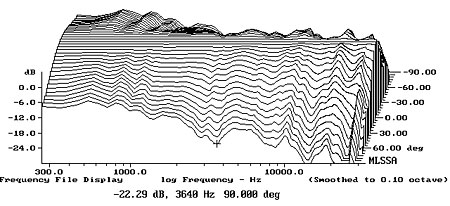
Fig.5 KEF Reference 207/2, lateral response family at 50", normalized to response on tweeter axis, from back to front: differences in response 90–5° off axis, reference response, differences in response 5–90° off axis.
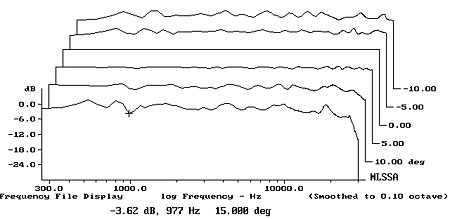
Fig.6 KEF Reference 207/2, vertical response family at 50", normalized to response on tweeter axis, from back to front: differences in response 10–5° above axis, reference response, differences in response 5–10° below axis.
Fig.7 shows how all this anechoic behavior adds up in my listening room. Using SMUGSoftware's Fuzzmeasure program running on my laptop, in conjunction with a Metric Halo FireWire audio interface and an EarthWorks omnidirectional microphone, I calculate the average of twenty 1/6-octave–smoothed spectra taken for the left and right speakers individually in a vertical rectangular grid centered on the position of my ears in the listening chair. The spatial averaging minimizes the position-dependent peaks and dips in the bass and lower midrange, but apart from a dip between 40 and 50Hz, the KEFs produced a generally smoother response in this area than any other speaker I've tried in my room. The bass jumpers were set to their free-space position. With the help of reinforcement from the room boundaries, the 207/2 is still producing almost full output at 20Hz, while the slight slope down in the bass confirms what I heard: that the 207/2's low-frequency alignment achieves excellent extension without blur or boom. The KEF's higher-frequency balance smoothly and gently slopes down from 500Hz to 30kHz, as the room furnishings become increasingly absorptive. Again, this is textbook behavior, and can be contrasted with, for example, the behavior of the Escalante Fremont elsewhere in this issue.

Fig.7 KEF Reference 207/2, spatially averaged, 1/6-octave response in JA's listening room.
Turning to the time domain, the KEF's step response (fig.8) shows that each of the five drive-units (four if you count the twin woofers as one) is connected with positive acoustic polarity. It also shows that while the speaker is not time-coincident—the outputs of successively lower-frequency drivers arrive successively later in time—it is time-coherent, in that the step response of each unit smoothly hands over to that of the next lower in frequency. This correlates with the superb integration of their outputs seen in the frequency domain (fig.4). The cumulative spectral-decay plot on the tweeter axis (fig.9) is clean overall, though a slight amount of delayed energy can be seen just below 3kHz. This not as pronounced as a similar mode seen at about the same frequency in the first version of the 207 (see fig.8 in that review).
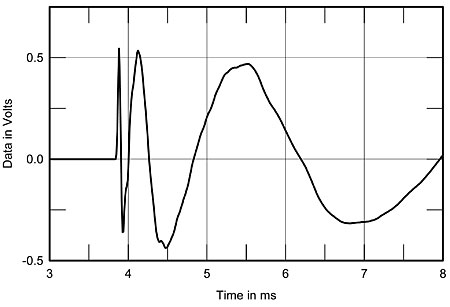
Fig.8 KEF Reference 207/2, step response on tweeter axis at 50" (5ms time window, 30kHz bandwidth).
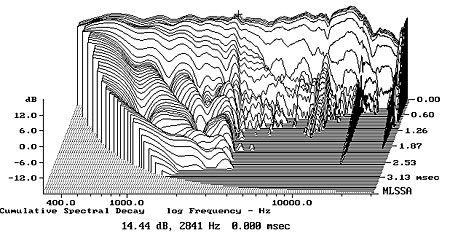
Fig.9 KEF Reference 207/2, cumulative spectral-decay plot at 50" (0.15ms risetime).
Taken overall, KEF's Reference 207/2 offers superb measured performance. This is a speaker for which no excuses need be made. That it sounds as good as it does is no mystery.—John Atkinson
- Log in or register to post comments




































